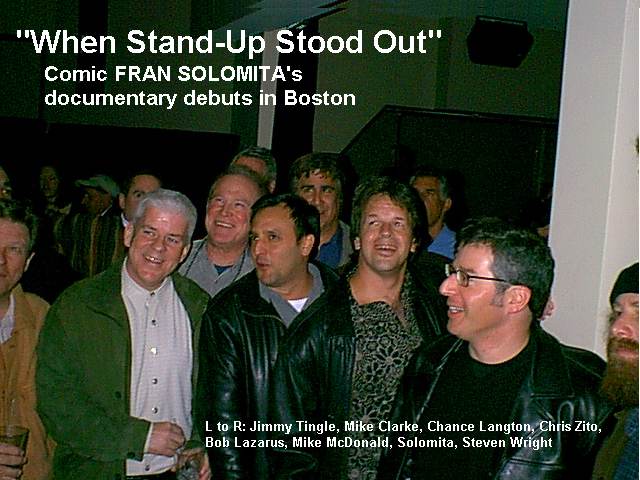
|
|
 |
SHECKYmagazine.com HOME | MAR-APR 2003 ISSUE |
|

|
|
One of the finest standup hotbeds of the modern
era is captured in a documentary called "When Stand-Up
Stood Out" We attended the premiere in Boston
--a review by Brian McKim Fran Solomita was one of the many fine comics who got polished in
the giant lapidary tumbler that was the standup comedy scene in
Boston in the 80s. It was a time and place that gave us a mini-
revolution of sorts in the standup biz and a breeding
ground unheard of outside of NY and LA-- thriving clubs elbow
to elbow in Boston's theater district affording dozens of comics
the chance to hone a killer club set, alternative rooms offering
perhaps the ideal creative atmosphere, a scene where the comics
were getting the ink and luring hotshot TV producers out of their
comfort zones. Through interviews, grainy video shot in dark clubs,
quick-cut footage taken of the Boston landscape and various
television clips, Solomita takes us from the early days, when
upstate NY native Barry Crimmins provided Boston acts with the
Ding Ho venue. Crimmins and company awakened Beantown entrepreneurs
to the potential of standup and lit the fuse that would eventually
result in the boom. Fortunately for the filmmakers, 80s comics were often
prone to spend the money left over from drink and drugs on
gadgets like video cameras. We're treated to a slim, rugby
shirt-clad Lenny Clarke whipping a crowd into a frenzy. We
see a bowtied Kevin Meaney as he harasses motorist passing
by on Comm Ave. outside Stitches. And we're privy to the
questionable goings-on at a comedy frat/boarding house dubbed
"The Barracks." Other present-day interviews supplement the narrative and
an especially humorous recollection by Colin Quinn goes a
long way toward our understanding of Nick's Comedy Stop, which
in turn affords us a real appreciation of Boston crowds
and the city of Boston in general. Additional chats with
Paula Poundstone, Bob Goldthwaite, Janeane Garofalo and
Denis Leary are detailed and entertaining. Personally, I began my relationship with the Boston market
at the end of the era depicted in the film-- the very
end, actually. I believe the year was 1984. I wangled an
invite to Boston from Billy Downs, who was running the Comedy
Connection at the time. I flew to Boston, took a cab to
Warrenton St. and was immediately whisked backstage, into the
little tiny ultra-terranean bunker they had back there. The
mood was somewhat subdued this evening, however, because
the news was rippling through the community that a room
had closed down. That room? The Ding Ho. At the time,
I didn't fully grasp the importance at the time, but over
the next few years, I learned what it had meant to the
comics who worked there. I hope nobody blames me!
The above pictures were taken at the Soho restaurant in
Brighton, during the heavily-attended premiere party just
before the screening at the Coolidge Corner Theater, which
was a wildly successful, near-sellout. We'd like to once
again thank Sandra Sullivan and the Boston Video and Film
Festival. (Hit www.bfvf.org.)
For more information on the movie, hit their website.
|
|
|
 |
SHECKYmagazine.com HOME | Back to the Top |
|
|